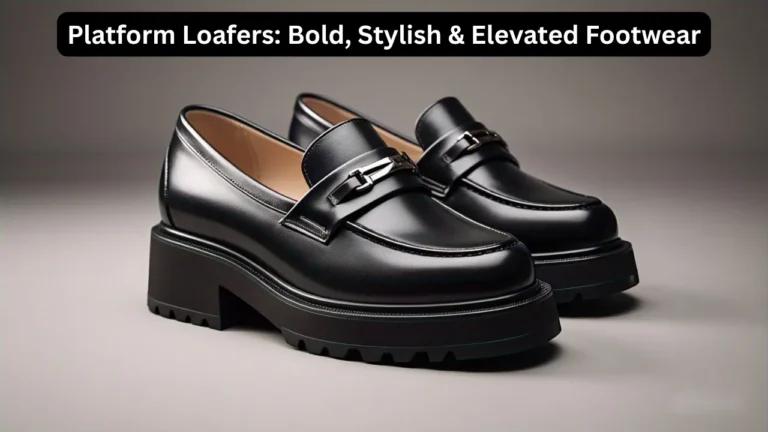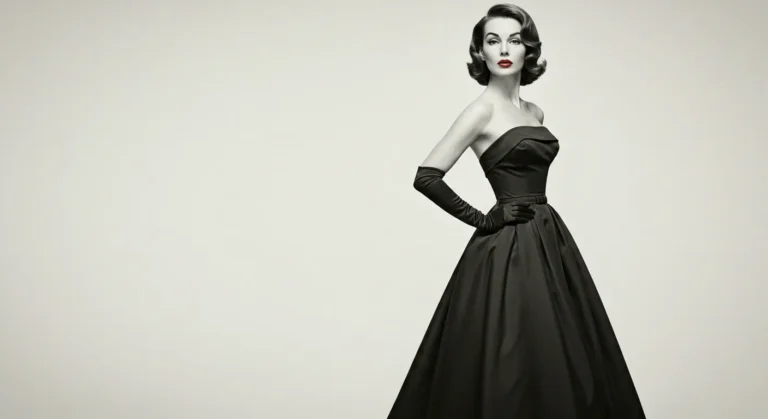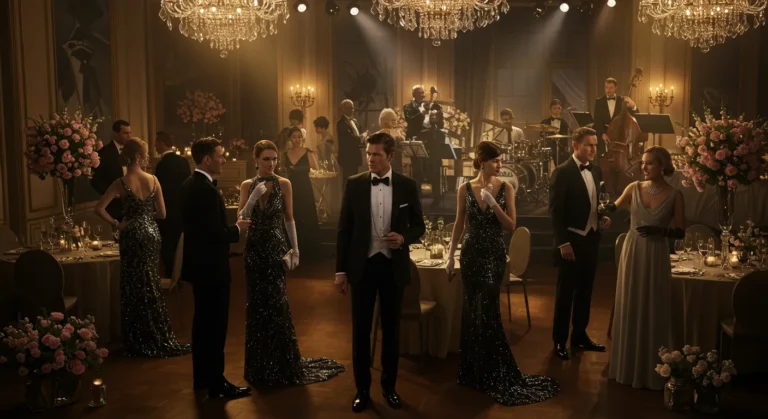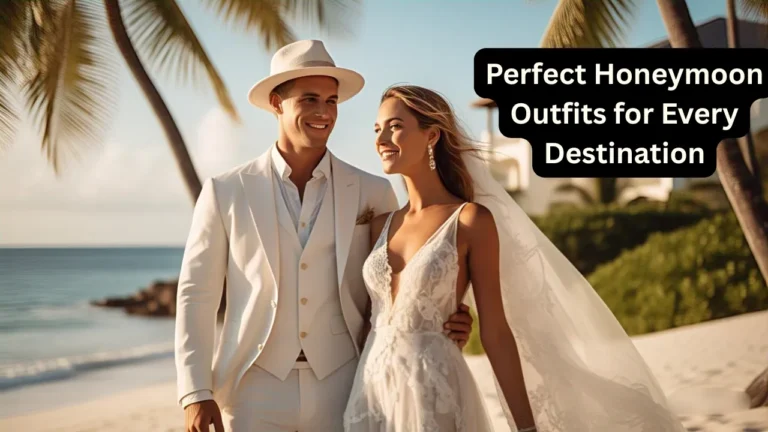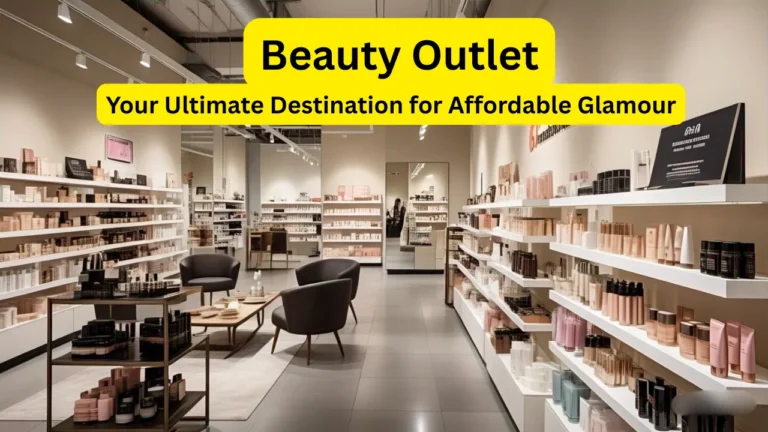best Vogue Billie Eilish Redefining Fashion, Fame, and style
Introduction
Billie Eilish is not just a global music sensation—she’s a fashion icon, a cultural phenomenon, and a symbol of modern youth rebellion. When she collaborates with a powerhouse like Vogue, the world pays attention. The phrase “Vogue Billie Eilish” has come to represent more than just a photoshoot or a magazine spread—it’s a defining moment in contemporary style and social commentary. Over the years, Vogue has documented and helped shape the evolution of many artists, but few partnerships have sparked as much conversation and introspection as its features with Billie Eilish.
From her early days of oversized clothing and moody aesthetics to her jaw-dropping bombshell transformation in recent years, Billie has used fashion as a form of expression, defiance, and storytelling. Each Vogue appearance she makes sends ripples through the fashion industry and social media alike. It’s not just about the clothes she wears—it’s about the message she sends, the boundaries she pushes, and the power she reclaims. That’s what makes the “Vogue Billie Eilish” collaboration such an impactful moment, not only in pop culture but in the ongoing conversation about body autonomy, identity, and the evolution of public personas.
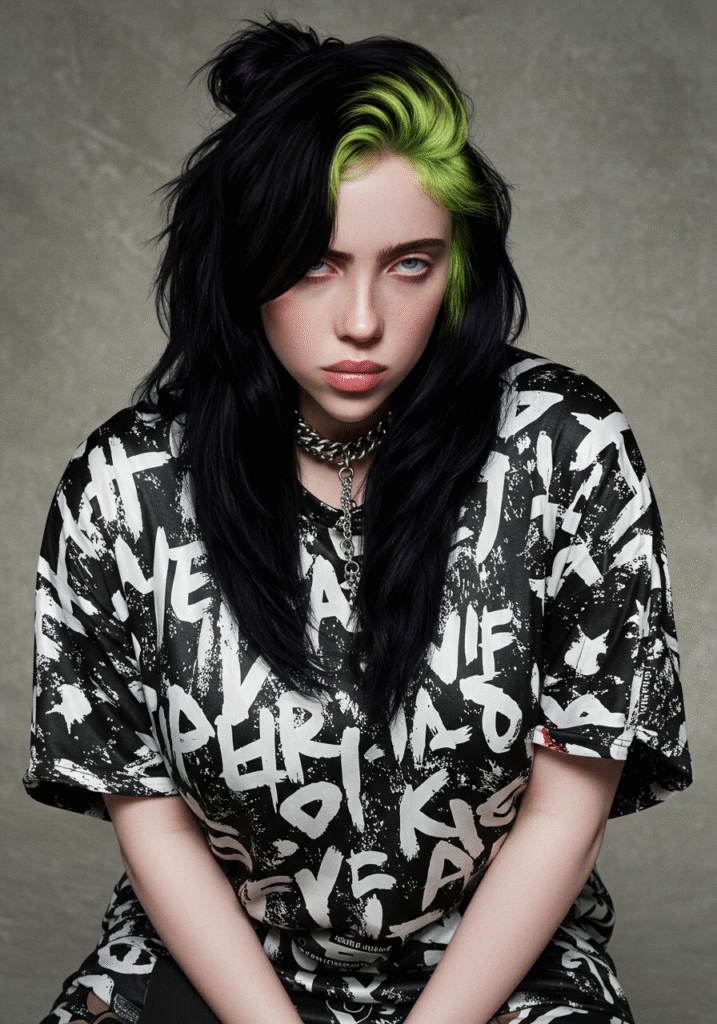
What sets Billie Eilish apart is that she doesn’t just follow trends—she sets them. And when Vogue gives her a platform, it amplifies her voice to a global audience hungry for authenticity. Whether she’s wrapped in a Gucci corset, lounging in vintage satin, or dressed head-to-toe in gender-neutral streetwear, every detail of a Billie Eilish Vogue shoot is dissected, discussed, and admired for its boldness and beauty.
As we dive into the most notable Vogue covers and interviews that have featured Billie Eilish, we’ll uncover the layers behind the visual storytelling, the impact on fashion and youth culture, and the transformative power of celebrity vulnerability. Let’s begin by looking at one of the most pivotal moments in this ongoing narrative: Billie Eilish’s 2021 British Vogue cover that sent shockwaves across the world.
The 2021 British Vogue Cover
Billie Eilish’s May 2021 cover for British Vogue wasn’t just a fashion statement—it was a cultural reset. Up until that point, Eilish had been known for her signature baggy clothes, neon roots, and anti-glam image. So when the world saw her draped in pink latex and old Hollywood curls, the reaction was explosive. The visuals were sultry, sophisticated, and so unlike anything she had done before. But make no mistake—this wasn’t a submission to traditional beauty standards. It was a reclamation of power.
Styled in a vintage-inspired pin-up look, the photos showcased Billie in corsets, gloves, and pastel hues—an aesthetic reminiscent of Marilyn Monroe, but with a Gen Z twist. The transformation shocked fans and critics alike, some praising her boldness while others questioned the departure from her earlier anti-sexualized image. However, Billie made it clear in the interview: the shoot was entirely her idea. It was her way of showing that embracing femininity and sensuality can coexist with feminism and agency.
The impact of the shoot was instant and massive. Social media exploded. Conversations around body image, personal expression, and societal double standards surged. Some called her a hypocrite, but many more applauded her for challenging the idea that women must stay within a single mold to be taken seriously.
Importantly, Billie addressed these criticisms head-on in the Vogue interview. She spoke about how women should be allowed to exist in multiple forms—sexual, serious, silly, strong—all at once. “My thing is that I can do whatever I want,” she declared, reinforcing the idea that choice is the cornerstone of empowerment.
In terms of SEO value, the 2021 Vogue Billie Eilish cover remains one of the most searched, analyzed, and discussed magazine spreads in the past decade. It even helped reframe the way Gen Z interprets celebrity fashion—less about conforming, more about evolving. Vogue gave Billie the space to redefine herself, and in doing so, allowed fans to reconsider what personal transformation really means.
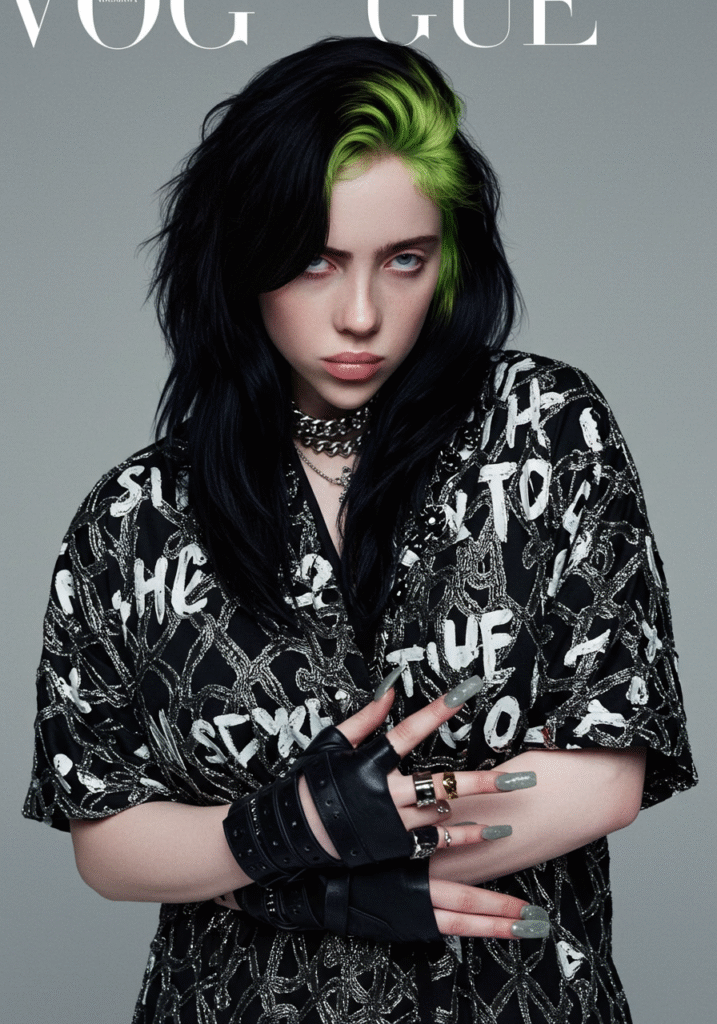
Fashion as a Form of Empowerment
Billie Eilish has always treated fashion as a medium for messaging. From the beginning of her career, her style choices were deliberate acts of rebellion against hypersexualization in pop culture. The oversized hoodies, loose pants, and bold graphics were not simply aesthetic choices—they were armor. She once stated that dressing baggily allowed her to avoid being judged or sexualized by the public, allowing her music and voice to speak louder than her appearance.
But the “Vogue Billie Eilish” moments mark a clear pivot—a shift from using fashion to hide to using fashion to highlight her agency. Instead of reacting to the male gaze, Billie now redefines it. She dresses for herself, not for approval. In Vogue interviews, she often emphasizes that her clothing choices are extensions of her moods and phases. One day she might be in head-to-toe Chanel; the next, in boxy streetwear and Nike Dunks. Each outfit tells a different story—and each one is valid.
This duality resonates deeply with her fan base, especially young women who are navigating their own identities. Billie’s unapologetic approach to personal style serves as a blueprint for those who wish to break free from societal expectations. By being unafraid to shift, change, and evolve, she encourages others to do the same.
From a fashion industry perspective, Billie has carved out a niche that defies conventional celebrity styling. Brands now compete to work with her, not just because of her reach, but because of what she represents—individuality, reinvention, and relevance. She doesn’t chase trends; she redefines them. That’s why each Vogue spread becomes an instant cultural artifact. The lighting, the mood, the tailoring—all curated not just for fashion lovers, but for a global audience hungry for substance beneath the surface.
So when Billie Eilish appears in Vogue, she’s not just wearing clothes. She’s wearing confidence, intention, and evolution. Whether it’s a satin gown or a punk-inspired ensemble, the message is always clear: this is who I am right now—and I don’t owe you consistency.
The Evolution of Billie Eilish’s
Billie Eilish’s fashion journey has been anything but ordinary. From her early days of oversized streetwear to her bold lingerie-clad transformation on the cover of British Vogue in 2021, every appearance in the magazine has marked a deliberate step in her fashion evolution. Vogue has been the visual diary chronicling that metamorphosis, showcasing how Billie’s identity isn’t static—it’s layered, expressive, and continually reborn.
Early in her career, Billie famously wore baggy clothes to deflect the world’s obsession with female bodies. Vogue subtly supported this decision in its features, focusing not just on what she wore, but why she chose to wear it. It wasn’t just fashion—it was a rebellion, a personal manifesto. But her bold 2021 Vogue cover told a different story: one where she reclaimed her body, her sensuality, and her voice, on her own terms. Draped in corsets, stockings, and pastel latex, she shattered every expectation placed on her. Critics either praised the empowerment or questioned her motives—but that’s the essence of Vogue-worthy transformation. It made the world talk.
Eilish’s fashion statements through Vogue go deeper than just clothing. They reflect empowerment, control, vulnerability, and rebellion—all filtered through the lens of an artist who refuses to be boxed in. She has played with vintage Hollywood glamor, punk-inspired edge, and surrealist fantasy—all while staying rooted in her own ethos. Vogue gave her the stage to express that complexity.
From the bold bleached-blonde bombshell to the dark-haired mystery cloaked in a trench coat, Billie’s style tells stories without her having to speak a word. Through every shoot and interview, Vogue has allowed Billie to explore and redefine what being a fashion icon means—not based on trends, but on truth. And that’s a kind of fashion power that’s unforgettable.
Cultural Impact
Billie Eilish’s Vogue appearances are more than just high-fashion features—they’re seismic cultural events that resonate with an entire generation. For Gen Z, she represents a new kind of celebrity: one who is transparent, vulnerable, boundary-pushing, and deeply human. When Billie appears in Vogue, she’s not just modeling clothes—she’s modeling values, fears, hopes, and resistance.
Take her groundbreaking British Vogue cover. It wasn’t just an aesthetic shift—it was a political statement. Here was a young woman, previously known for shrouding her body in mystery, boldly owning her sexuality on a global stage. And she did it without selling out her authenticity. That move challenged decades of expectations placed on female celebrities, making her a lightning rod for conversations around feminism, consent, body autonomy, and the male gaze.
Gen Z, already fluent in the language of social change, saw Billie as one of their own—a peer using her influence to tear down the same systems they protest online. Vogue became a visual amplifier for that message. When Billie spoke about body image, mental health, or misogyny in her Vogue interviews, her words didn’t just stay in print. They echoed across TikTok, Instagram, and YouTube, sparking debates, think pieces, and thousands of stitched reaction videos.
Billie’s authenticity strikes at the heart of a generation disillusioned by performative fame. She talks about therapy, insecurity, and self-doubt while standing draped in couture. She laughs, curses, and admits she doesn’t always have it figured out. That rawness is precisely why Gen Z trusts her—and by extension, trusts what she says in Vogue.
In a world saturated with filtered perfection and brand-driven personas, Billie Eilish in Vogue is a rare sight: unfiltered truth in high fashion. That’s why her features don’t just trend—they endure.
The Role of Vogue in Shaping Billie Eilish’s
Few platforms possess the kind of cultural clout that Vogue does, and when it intersects with a phenomenon like Billie Eilish, the impact is immortalized. Vogue hasn’t merely documented Billie’s rise—it’s helped shape her legacy.
First and foremost, Vogue gave Billie a space to explore facets of her identity that might have gone unexplored in traditional media. Whether it’s her vulnerable commentary on fame or her bold fashion choices, the magazine has always offered her a canvas large enough to fit her ever-expanding persona. These features go beyond clothing and visuals—they become time capsules that future generations will refer to when tracing the evolution of 21st-century pop icons.
Furthermore, Vogue adds a layer of credibility and prestige that cements Billie’s place among the fashion and cultural elite. Appearing in Vogue is not just about a photoshoot—it’s about entering the pantheon of icons. The magazine doesn’t merely reflect popularity; it affirms influence. And Billie Eilish, with every issue she graces, further establishes herself not just as a musician or an influencer, but as a generational voice.
Vogue also provides a narrative structure to Billie’s career. As she moves through different musical eras and emotional landscapes, Vogue encapsulates each transformation through stylized imagery and deeply personal interviews. The magazine captures not only what Billie looks like at that moment, but who she is. And that ongoing collaboration becomes a layered, evolving portrait—one that adds dimension to her artistry.
In essence, Vogue hasn’t just featured Billie Eilish—it has partnered in the writing of her legacy. And as long as Billie continues to evolve, challenge, and inspire, you can be certain that Vogue will be there, camera in hand, capturing history in real-time.
Billie Eilish and the Politics of Fashion
Billie Eilish has become more than just a fashion icon; she’s now a walking political statement. Her fashion choices, especially when featured in Vogue, speak volumes about societal pressures, feminism, body autonomy, and identity. This power to use her body and clothing as a form of protest and expression is not accidental—it’s calculated, deliberate, and deeply personal.
The 2021 British Vogue cover marked a turning point. The sultry corsets and pin-up inspired look clashed sharply with her earlier streetwear identity. The media immediately pounced. Was she selling out? Had she given in to the beauty standards she once criticized? But Eilish, ever self-aware, addressed this herself: “It’s all about what makes you feel good.”
This shift in fashion wasn’t about betrayal; it was about evolution. Eilish showed the world that embracing femininity doesn’t negate feminism. That a woman can be powerful in baggy pants or in a custom Mugler catsuit. Vogue, known for shaping narratives, allowed Billie to reclaim her body—her way, in her words, on her terms.
Her transformation also challenged the hypocritical double standards imposed on women. When she covered her body, she was criticized for hiding. When she revealed it, she was called a sellout. Billie used the Vogue platform to spotlight this double bind. Fashion became a lens to dissect how women are scrutinized no matter what they wear.
Eilish’s collaboration with Vogue isn’t just a celebrity flaunting high fashion—it’s an ongoing conversation about the cultural meaning behind clothing. Every photo, every quote, every style choice adds fuel to the larger feminist discourse. And that’s what makes her relationship with Vogue so electric—it’s fashion as protest, couture as commentary.
Aesthetic Evolution
No discussion of Billie Eilish’s Vogue transformation is complete without addressing her drastic hair evolution. Her green roots and black hair became iconic—an emblem of rebellion and teenage angst. But when she revealed her blonde bombshell look in Vogue, the internet stopped. Literally. The reveal photo broke Instagram records, becoming one of the most-liked posts of all time.
But the color change wasn’t just aesthetic. It was symbolic. Billie told Vogue that going blonde was about reinvention. She wanted to disappear, blend in, and explore a new side of herself. This desire to not be recognized contradicts the celebrity impulse for visibility. It was yet another paradox that defined Billie Eilish: craving anonymity while commanding global attention.
The blonde era also mirrored a deeper confidence. Eilish stepped into a softer, more sensual version of herself, which was amplified in her Vogue visuals. The change didn’t just stun fans; it became a cultural moment that redefined the idea of beauty reinvention. Suddenly, it was okay to shift, evolve, and even contradict your past self.
What Vogue captured wasn’t just a hairstyle, but a metamorphosis. A 19-year-old girl turning into a woman who owned her image. Fashion, hair, and presence all aligned into a cohesive identity that was unapologetically fluid.
In pop culture, where women are often boxed in by consistency, Billie shattered expectations. Going from baggy neon goth to glamorous blonde goddess would have broken many artists—but for Eilish, it was liberation. And Vogue was the perfect stage.
The Influence
It’s not an exaggeration to say Billie Eilish’s Vogue covers have left a cultural imprint. She didn’t just influence style—she reshaped how a generation views authenticity, body image, and self-expression.
Teens and young adults saw in Billie a reflection of their own contradictions. A person navigating fame, identity, anxiety, and empowerment—all while refusing to be molded by the industry. Her bold shifts in style, especially her 2021 Vogue moment, validated the messy, evolving journey of growing up. You can go from tomboy to glam, from scared to strong, and still be wholly you.
On platforms like TikTok and Instagram, her Vogue photos were dissected, mimicked, debated, and worshipped. Fashion bloggers labeled her a Gen Z icon. Feminist circles hailed her as a body autonomy advocate. Even mainstream media took cues—suddenly, more outlets were willing to showcase vulnerability, imperfection, and emotional honesty in celebrity narratives.
Her Vogue moment also sparked important conversations in schools, dorms, and dining rooms. Why are women criticized for owning their sexuality? Why is softness seen as weakness? Why must a woman be one thing?
In shifting the cultural lens, Billie’s impact went beyond music or fashion. She redefined what it means to come of age in public. Vogue may have printed the pages, but Billie Eilish wrote the narrative.
FAQs
How many times has Billie Eilish appeared in Vogue magazine?
Billie Eilish has graced the cover of Vogue multiple times, including U.S. and international editions. Each feature showcases a different facet of her evolving identity and style.
Why was Billie Eilish’s British Vogue cover so controversial?
The 2021 British Vogue cover marked a dramatic transformation from her usual oversized clothing to a form-fitting corset and lingerie-inspired look. Fans and critics were surprised, sparking debates around body image, empowerment, and public perception.
Who styled Billie Eilish for her Vogue appearances?
Stylists such as Dena Giannini and editors like Edward Enninful have played a key role in shaping her Vogue looks, often collaborating closely with Billie to ensure authenticity and intentionality.
What impact has Billie Eilish had on fashion?
Billie has influenced a wave of individuality in fashion. She’s made gender-fluid styling, oversized silhouettes, and body autonomy mainstream, encouraging others to embrace personal expression.
Does Billie Eilish design any of her own looks?
While Billie collaborates with stylists and designers, she’s heavily involved in choosing pieces that reflect her vision. She’s known for curating her public image with intention and care.
How does Billie Eilish balance fashion with her music career?
For Billie, fashion is an extension of her artistry. Her visual identity complements her musical themes, allowing her to tell holistic stories that blend style and sound seamlessly.
What does Billie Eilish represent to Gen Z?
Billie represents authenticity, rebellion, and empowerment. Her refusal to conform has made her a voice for mental health awareness, body positivity, and creative freedom — core values for Gen Z.
Conclusion
Billie Eilish’s presence on the cover of Vogue has become more than just a fashion moment — it’s a cultural turning point. From her musical genius to her evolving sense of style, each appearance signifies growth, strength, and authenticity. Through her Vogue features, Billie has shattered stereotypes, redefined what beauty means in pop culture, and opened up important conversations around body image, mental health, and artistic independence.
In the early stages of her career, Billie challenged the industry by rejecting traditional pop star aesthetics. Her first Vogue appearance maintained that defiance but with an edge of mystery — oversized silhouettes, sharp contrasts, and defiant energy. Then came her British Vogue transformation in 2021, a bold and feminine visual that shocked the public and delighted critics. She proved that no one could box her into a category. That photo shoot wasn’t about pleasing the masses; it was about reclaiming power over her own image.
Her subsequent appearances in Vogue have continued that evolution. Whether she’s experimenting with vintage glamour or making subtle nods to punk, every photoshoot tells a story of a young woman who is in control of her destiny. And fans have resonated with this journey. Billie Eilish has empowered millions to embrace fluidity in identity, style, and self-expression.
Vogue and Billie Eilish form a perfect partnership. The magazine, known for spotlighting icons and risk-takers, found in Billie someone who can break the mold and reinvent herself without losing authenticity. Billie, in return, found a platform that amplified her voice beyond the music charts. Together, they’ve created unforgettable visuals that will be remembered in fashion and pop culture history for decades to come.
In a world often obsessed with perfection and predictability, Billie Eilish is the antithesis: raw, real, and revolutionary. Her Vogue stories reflect not only her personal growth but the shifting tides of an entire generation. She’s not just influencing style; she’s rewriting the rules. And for that, Billie Eilish’s journey with Vogue is a legacy still unfolding — one cover at a time.


